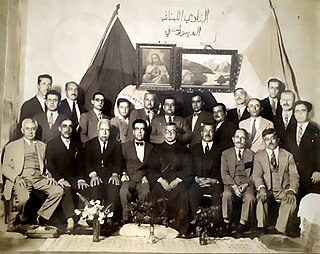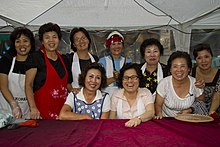
Arab diaspora is a term that refers to descendants of the Arab emigrants who, voluntarily or as forcibly, migrated from their native lands to non-Arab countries, primarily in the Americas, Europe, Southeast Asia, and West Africa.
Latin Americans are the citizens of Latin American countries.
Asian Latin Americans are Latin Americans of Asian descent. Asian immigrants to Latin America have largely been from East Asia or West Asia. Historically, Asians in Latin America have a centuries-long history in the region, starting with Filipinos in the 16th century. The peak of Asian immigration occurred in the 19th and 20th centuries. There are currently more than four million Asian Latin Americans, nearly 1% of Latin America's population. Chinese, Japanese, and Lebanese are the largest Asian ancestries; other major ethnic groups include Filipinos, Syrians, Indians, and Koreans. Brazil is home to the largest population of East Asian descent, estimated at 2.08 million. The country is also home to a large percentage of West Asian descendants. With as much as 5% of their population having some degree of Chinese ancestry, Peru and Mexico have the highest ratio of any country for East Asian descent. Though the most recent official census, which relied on self-identification, gave a much lower percentage.
Asian Brazilians refers to Brazilian citizens or residents of Asian ancestry. The vast majority trace their origins to Western Asia, particularly Lebanon, or East Asia, namely Japan. The Brazilian census does not use "Asian" as a racial category, though the term "yellow" refers to people of East Asian ethnic origin.

Arab Brazilians are Brazilian citizens of Arab ethnic, cultural, linguistic heritage and identity. The majority of Arab Brazilians trace their origin to the Levantine region of the Arab World, known in Arabic as Bilad al-Sham, primarily from Lebanon and Syria, as well as Palestine. Arab Brazilians are Christians in the great majority. The first Syrians and Lebanese arrived in São Paulo around 1880. It is not known exactly when, although the Syrians and Lebanese say that in 1885 there was a small core of peddlers working in the market square. By 1920, the census listed 50,246 Syrians and Lebanese in Brazil, 38.4% (2/5) of these in the state of São Paulo. The 1940 census enumerated 48,614 Syrians, Lebanese and other related groups with a decrease of approximately 1647 people. As immigration almost ceased after 1929 and the colony aged, it is surprising that the decline was not even greater. The trend of the period between 1920 and 1940 was the continuous concentration of Syrians and Lebanese in São Paulo. Almost half (49.3%) of Syrians and Lebanese residents in Brazil lived in São Paulo.

Immigration to Mexico has been important in shaping the country's demographics. Since the early 16th century, with the arrival of the Spanish, Mexico has received immigrants from Europe, Africa, the Americas, and Asia. Today, millions of their descendants still live in Mexico and can be found working in different professions and industries.

Argentina has a racially and ethnically diverse population. The territory of what today is Argentina was first inhabited by numerous indigenous peoples. The first white settlers came during the period of Spanish colonization, beginning in the 16th century. The Spaniards imported African slaves, who would go on to become the first Afro-Argentines. Following independence from Spain in the 19th century and well into the 20th century, numerous migration waves took place, with Argentina being the second most popular destination for migrants in the early 20th century, after the United States. Most of these migrants came from Europe.

Julio Daniel Asad is an Argentine former football player and manager. He played as a midfielder, and participated with Argentina in the 1975 Copa América.
Arab Colombians refers to Arab immigrants and their descendants in the Republic of Colombia. Most of the migrants came from Lebanon, Jordan, Syria and Palestine. When they were first processed in the ports of Colombia, they were classified as Turks because what is now Lebanon, Syria, Jordan and Palestine were then territories of the Ottoman Empire. It is estimated that Colombia has a Lebanese population of 3.2 million. Meanwhile the Palestine population is estimated between 100,000-120,000.
Omar Andrés Asad is an Argentine football manager and former player who played as a forward.
Arab Argentine refers to Argentine citizens or residents whose ancestry traces back to various waves of immigrants, largely of Arab ethnic, cultural and linguistic heritage and/or identity originating mainly from what is now Lebanon and Syria, but also some individuals from the twenty-two countries which comprise the Arab world such as Palestine, Egypt and Morocco. Arab Argentines are one of the largest Arab diaspora groups in the world.
Arab Chileans are Chileans from predominantly Arab ancestry. People from the Arab world arrived in Chile as early as the mid-19th century. Historically, the Arabs of Chile were called Turks, Moors, Syrians, Lebanese, or Palestinians.

Venezuelans are the citizens identified with the country of Venezuela. This connection may be through citizenship, descent or cultural. For most Venezuelans, many or all of these connections exist and are the source of their Venezuelan citizenship or their bond to Venezuela.

Diplomatic relations between the countries Argentina and Lebanon, have existed for over a century. Both nations enjoy friendly relations, the importance of which centers on the history of Lebanese immigration to Argentina. There are approximately 1.5 million Argentines of Lebanese descent. The Lebanese community in Argentina is the third largest immigrant community in the country and Argentina is host to the second largest community in Latin America. Both nations are members of the Group of 24 and the United Nations.
Arab Venezuelans refers to Venezuelan citizens of Arab origin or descent. There are around 1,600,000 Venezuelans of Arab origin, mainly from Lebanon, Syria and Palestine. Most Arab Venezuelans are of Syrian descent with their number between 400,000 and 1 million inhabitants, and Lebanese descent with their number between 341,000 and 500,000.
White Colombians are the Colombian descendants of European and Middle Eastern people living in Colombia. According to the 2018 census, 87.58% of Colombians do not identify with any ethnic group, thus being either white or mestizo, which are not categorized separately.

Argentines are the people identified with the country of Argentina. This connection may be residential, legal, historical or cultural. For most Argentines, several of these connections exist and are collectively the source of their being Argentine. In the past the National Gentilic for Citizens of Argentina was mistakenly translated as Argentinians, a term that is no longer considered accurate.
Lebanese Colombians are Colombians of Lebanese descent. Most of the Lebanese community's forebears immigrated to Colombia from the Ottoman Empire in the late 19th and early 20th centuries for economic, political and religious reasons. The first Lebanese moved to Colombia in the late nineteenth century. There was another wave in the early twentieth century. It is estimated that over 10,000 Lebanese immigrated to Colombia from 1900 to 1930.
Lebanese Argentine refers to Argentine citizens of Lebanese descent or Lebanon-born people who reside in Argentina. Many of the Lebanese Argentines are descendants of immigrants cultural and linguistic heritage and/or identity, originating from what is now Lebanon.
Syrian Argentines are Argentine citizens of Syrian descent or Syrian-born people who reside in Argentina. Argentina has the second highest number of Syrians in South America after Brazil. Syrian immigration to Argentina has been and is currently, one of the most important Arab migration flows into Argentina. Immigration waves peaked in the 20th century, although in recent years due to the constant wars in the Middle East, immigration from Syria has been increasing over time. Like other Arab Argentines, they are universally known as "turcos" ("Turks"), like in the rest of Latin American countries.










